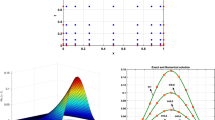Abstract
In this paper, we derive a compact implementation of the discrete time Zhang neural network for computing the solution of an \(n\times n\) Toeplitz linear system. In the proposed scheme, the multiplication of the weight matrix by the input vector is performed efficiently in \(O(n\log n)\) operations using the fast Fourier transform instead of \(O(n^{2})\) in the original Zhang neural network. We have investigated also the use of the proposed neural network to compute the Toeplitz matrices inversion; it consists of dividing the system into n Toeplitz sub-systems requiring n independent subnets similar to the one used for solving the Toeplitz system. In another way, the computation of the first and the last columns of the matrix inverse is sufficient to compute the matrix inverse via the Gohberg–Semencul formulas, in this case only two subnets are needed to define all elements of the matrix inverse.








Similar content being viewed by others
References
Pan V (2001) Structured matrices and polynomials: unified superfast algorithms. Birkhauser, Boston
Gohberg I, Olshevksy V (1994) Complexity of multiplication with vectors for structured matrices. Linear Algebra Appl 202:163–192
Ammar G, Gader P (1991) A variant of the Gohberg–Semencul formula involving circulant matrices. SIAM J Matrix Anal Appl 12(3):534–540
Jun Y, Xiaokang Y, Fei G, Dacheng T (2016) Deep multimodal distance metric learning using click constraints for image ranking. IEEE Trans Cybern. doi:10.1109/TCYB.2016.2591583
Chaoqun H, Jun Y, Jian W, Dacheng T, Meng W (2015) Multimodal deep autoencoder for human pose recovery. IEEE Trans Image Process 24(12):5659–5670
Chaoqun H, Jun Y, Dacheng T, Meng W (2015) Image-based three-dimensional human pose recovery by multiview locality-sensitive sparse retrieval. IEEE Trans Ind Electron 62(6):3742–3751
Zhang Y, Zhao D, Sun J et al (2016) Adaptive convolutional neural network and its application in face recognition. Neural Process Lett 43(2):389–399
Wang J (1993) A recurrent neural network for real-time matrix inversion. Appl Math Comput 55(1):89–100
Jiang D (2004) Analog computing for real-time solution of time-varying linear equations. In: Proceedings of international conference on communications, circuits and systems, Chengdu, China, pp 1367–1371
Yi C, Zhang Y (2008) Analogue recurrent neural network for linear algebraic equation solving. Electron Lett 44(18):1078–1079
Zhang Y, Mu B, Zheng H (2011) Discrete-time zhang neural network and numerical algorithm for time-varying linear equations solving. In: Proceedings of the 2011 IEEE international conference on mechatronics and automation August 7–10, Beijing, China, pp 938–943
Zhang Y, Yi C, Ma W (2009) Simulation and verification of Zhang neural network for online time-varying matrix inversion. Simul Model Pract Theory 17(10):1603–1617
Zhang Y, Guo D, Li Z (2013) Common nature of learning between back-propagation and hopfield-type neural networks for generalized matrix inversion with simplified models. IEEE Trans Neural Netw Learn Syst 24(4):579–592
Xiao L, Zhang Y (2014) From different Zhang functions to various ZNN models accelerated to finite-time convergence for time varying linear matrix equation. Neural Process Lett 39:309–326
Author information
Authors and Affiliations
Corresponding author
Rights and permissions
About this article
Cite this article
Charif, F., Benchabane, A. & Bennia, A. A Simplified Architecture of the Zhang Neural Network for Toeplitz Linear Systems Solving. Neural Process Lett 47, 391–401 (2018). https://doi.org/10.1007/s11063-017-9656-9
Published:
Issue Date:
DOI: https://doi.org/10.1007/s11063-017-9656-9




